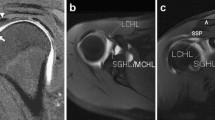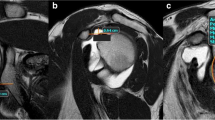Abstract
Purpose
This study was undertaken to evaluate magnetic resonance (MR) arthrography in the detection and classification of lesions that may cause superior instability.
Materials and methods
Forty-two consecutive patients with clinical signs of chronic superior instability of the shoulder underwent MR arthrography followed by arthroscopic surgery. For each patient we retrospectively reviewed the MR arthrography and surgical findings.
Results
We detected 31 superior labral anterior posterior (SLAP) lesions, all confirmed on arthroscopy with three cases of underestimation: in the detection of SLAP lesions, the sensitivity, specificity, accuracy, positive predictive value (PPV) and negative predictive value (NPV) of MR arthrography were 100%; in the evaluation of the type of SLAP lesion, sensitivity was 100%, specificity was 78.5%, accuracy was 92.8%, PPV was 71.7% and NPV was 100%. All cases of capsular laxity (13/42) and biceps tendon lesions (3/42) were confirmed on arthroscopy with sensitivity, specificity, accuracy, PPV and NPV of 100%. Eleven cuff lesions were detected on MR arthrography, 10 of which confirmed at arthroscopy: sensitivity was 100%, specificity was 96.8%, accuracy was 97.6%, PPV was 90.9% and NPV was 100%. Associated lesions were found in 38/42 patients.
Conclusions
Superior instability is frequently associated with different anatomical variants or pathological conditions, such as SLAP lesions. The role of MR arthrography is to describe the key features of lesions affecting the superior portion of the shoulder, including location, morphology, extent, and associated injuries and leanatomical variants and to correlate these features with clinical symptoms.
Riassunto
Obiettivo
Scopo del presente lavoro è stato valutare il ruolo dell’artro-risonanza magnetica (RM) nell’identificazione e nella classificazione delle lesioni che possono essere alla base dell’instabilità superiore di spalla.
Materiali e metodi
Quarantadue pazienti consecutivi con segni clinici di instabilità superiore cronica di spalla sono stati sottoposti ad artro-RM e successiva artroscopia chirurgica. Per ogni paziente abbiamo retrospettivamente considerato i reperti artro-RM e i reperti artroscopici.
Risultati
Abbiamo riscontrato 31 lesioni del labbro glenoideo superiore da anteriore a posteriore (SLAP lesions), tutte confermate all’esame artroscopico con 3 casi di sottostima del grado di lesione: nella individuazione delle SLAP lesions la sensibilità, specificità, accuratezza, valore predittivo positivo (VPP) e valore predittivo negativo (VPN) dell’artro-RM sono risultati del 100%; nella valutazione del tipo di SLAP lesion la sensibilità è stata del 100%, la specificità del 78,5%, l’accuratezza del 92,8%, il VPP del 71,7% e il VPN del 100%. Tutti i casi di lassità capsulo-legamentosa (13/42) e di lesione del tendine del capo lungo del bicipite (3/42) sono stati confermati all’artroscopia con sensibilità, specificità, accuratezza, VPP e VPN del 100%. Delle 11 lesioni dei tendini della cuffia dei rotatori diagnosticate con artro-RM, 10 sono state confermate artroscopicamente con sensibilità del 100%, specificità del 96,8%, accuratezza del 97,6%, VPP del 90,9% e VPN del 100%. Lesioni associate sono state diagnosticate in 38/42 pazienti.
Conclusioni
L’instabilità superiore di spalla è frequentemente associata a condizioni patologiche, come le SLAP lesions o a varianti anatomiche. Il ruolo dell’artro-RM è quello di valutare le caratteristiche delle lesioni della porzione sovraequatoriale della spalla, descrivendone la sede, la morfologia e l’estensione e di identificare e descrivere la presenza di lesioni e varianti anatomiche associate.
Similar content being viewed by others
References/Bibliografia
Ly JQ, Beall DP, Sanders TG (2003) MR imaging of glenohumeral instability. AJR Am J Roentgenol 181:203–213
Matsen FA, Thomas SC, Rockwood CA (1990) Anterior glenohumeral instability. In: Rockwood CA, Matsen FA (eds) The shoulder. WB Saunders, Philadelphia, p 256
Lippitt SB, Harryman DT, Sidles JS et al (1991) Diagnosis and management of AMBRI syndrome techniques. Tech Orthop 6:61–73
Castagna A, Nordenson U, Garofalo R et al (2007) Minor shoulder instability. Arthroscopy 23:211–215
Chang D, Mohana-Borges A, Borso M et al (2008) SLAP lesions: anatomy, clinical presentation, MR imaging diagnosis and characterization. Eur J Radiol 68:72–87
Bennet WF (2001) Subscapularis, medial and lateral coracohumeral ligament insertion anatomy: arthroscopic appearance and incidence of “hidden” rotator interval lesions. Arthroscopy 17:173–180
Jost B, Koch PP, Gerber C (2000) Anatomy and functional aspects of the rotator interval. J Shoulder Elbow Surg 9:336–341
De Maeseneer M, Van Roy F, Lenchik L et al (2000) CT and MR arthrography of the normal and pathologic anterosuperior labrum and labral-bicipital complex. Radiographics 20:S67–S81
Morag Y, Jacobson JA, Shields G et al (2005) MR arthrography of rotator interval, long head of the biceps brachii, and biceps pulley of the shoulder. Radiology 235:21–30
Van der Woude HJ, Vanhoenacker FM (2007) MR arthrography in glenohumeral instability. JBR-BTR 90:377–383
Sher JS, Iannotti JP, Williams GR et al (1998) The effect of shoulder magnetic resonance imaging on clinical decision making. J Shoulder Elbow Surg 7:205–209
Tirman PFJ, Stauffer AE, Crues III JV et al (1993) Saline magnetic resonance arthrography in the evaluation of glenohumeral instability. Arthroscopy 9:550–559
Kwak SM, Brown RR, Resnick D et al (1998) Anatomy, anatomic variations and pathology of the 11- to 3-o’clock position of the glenoid labrum:findings of MR arthrography and anatomic sections. AJR Am J Roentgenol 171:235–238
Yi-Chih Hsu, Pan RY, Shih YY et al (2010) Superior-capsular elongation and its significance in atraumatic posteroinferior multidirectional shoulder instability in magnetic resonance arthrography. Acta Radiol 51:302–308
Munro W, Healy R (2009) The validity and accuracy of clinical tests used to detect labral pathology of the shoulder. A systematic review. Man Ther 14:119–130
Snyder SJ, Karzel RP, Del Pizzo W et al (1990) SLAP lesions of the shoulder. Arthroscopy 6:274–279
Le Huec JC, Schaeverbeke T, Moinard M et al (1996) Traumatic tear of the rotator interval. J Shoulder Elbow Surg 5:41–46
Walch G, Boileau P, Noel E et al (1991) Traitement chirurgical des épaules douloureuses par lésions de la coiffe et du long biceps en fonction des lésions. Réflexions sur le concept de Neer. Rev Rhum Mal Osteoartic 58:247–257
Walch G, Nove-Josserad L, Levigne C et al (1994) Complete ruptures of the supraspinatus tendon associated with “hidden lesions” of the rotator interval. J Shoulder Elbow Surg 3:353–360
Chung CB, Dwek JR, Cho GL et al (2000) Rotator cuff interval: evaluation with MR imaging and MR arthrography of the shoulder in 32 cadavers. J Comput Assist Tomogr 24:738–743
Schenk TJ, Brems JJ (1998) Multidirectional instability of the shoulder: pathophysiology, diagnosis and management. J Am Acad Orthop Surg 6:65–72
Kreitner KF, Botchen K, Rude J et al (1998) Superior labrum and labralbicipital complex: MR imaging with pathologic-anatomic and histologic correlation. AJR Am J Roentgenol 170:599–605
Gaskin CM, Golish SR, Blount KJ et al (2007) Anomalies of the long head of the biceps brachii tendon: clinical significance, MR arthrography findings and arthroscopic correlation in two patients. Skeletal Radiol 36:785–789
Petersson JC (1986) Spontaneous medial dislocation of the tendon of the long biceps brachii: an anatomic study of the prevalence and pathomechanics. Clin Orthop Relat Res 211:224–227
Itoi E, Berglund LJ, Grabowski JJ et al (1998) Superior-inferior instability of the shoulder: role of the coracohumeral ligament and the rotator interval capsule. Mayo Clin Proc 73:508–515
Sethi N, Wright R, Yamaguchi K (1999) Disorders of the long head of the biceps tendon. J Shoulder Elbow Surg 8:644–654
Minkoff J, Stecker S, Cavaliere G (1997) Glenohumeral instabilities and role of MR imaging techniques. The orthopaedic surgeon’s perspective. Magn Reson Imaging Clin N Am 5:767–785
Smith DK, Chopp TM, Aufdemorte TB et al (1996) Sublabral recess of the superior labrum: study of cadavers with conventional nonenhanced MR imaging, MR arthrography, anatomic dissection and limits histologic examination. Radiology 201:251–256
Lee WH, McCauley TR, Katz LD et al (2001) Superior labral anterior posterior (SLAP) lesions of the glenoid labrum: reliability and accuracy of MR arthrography for diagnosis. Radiology 218:127–132
Tuite MJ, Rutkowski A, Enright T et al (2005) Width of high signal and extension posterior to biceps tendon as signs of superior labrum anterior to posterior tears on MRI and MR arthrography. AJR Am J Roentgenol 185:1422–1428
Magee T (2009) 3T MRI of the shoulder: is MR arthrography necessary? AJR Am J Roentgenol 192:86–92
Herold T, Hente R, Zorger N et al (2003) Indirect MR arthrography of the shoulder value in the detection of SLAP lesions. Rofo 175:1508–1514
Waldt S, Burkart A, Lange P et al (2004) Diagnostic performance of MR arthrography in the assessment of superior labral anteroposterior lesions of the shoulder. AJR Am J Roentgenol 182:1271–1278
Funk L, Snow M (2007) SLAP tears of the glenoid labrum in contact athletes. Clin J Sport Med 17:1–4
Applegate GR, Hewitt M, Snyder S et al (2004) Chronic labral tears: value of magnetic resonance arthrography in evaluating the glenoid labrum and labral bicipital complex. Arthroscopy 20:959–963
Author information
Authors and Affiliations
Corresponding author
Rights and permissions
About this article
Cite this article
Genovese, E., Spanò, E., Castagna, A. et al. MR-arthrography in superior instability of the shoulder: correlation with arthroscopy. Radiol med 118, 1022–1033 (2013). https://doi.org/10.1007/s11547-013-0942-y
Received:
Accepted:
Published:
Issue Date:
DOI: https://doi.org/10.1007/s11547-013-0942-y




